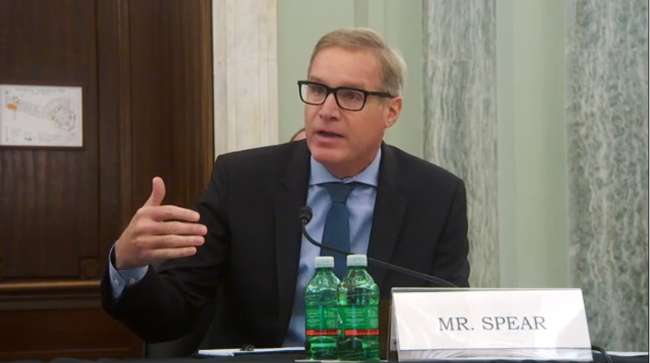Senior Reporter
ATA's Chris Spear Calls on Congress to Advance Surface Transportation Bill This Year

[Stay on top of transportation news: Get TTNews in your inbox.]
The adoption of legislation designed to improve connectivity across commercial corridors and ensure long-term funding for highway programs would benefit the country’s freight supply chain, the leader of the group representing the trucking sector told lawmakers May 11.
Speaking before the Senate Commerce Committee, American Trucking Associations President Chris Spear also touted legislation that would permit commercial drivers under the age of 21 to cross states lines as a way to ease the trucking industry’s persistent driver shortage, and keep supply chains moving.
“America’s supply chain yields tremendous potential. It’s a catalyst for economic growth, beyond that of any other nation,” Spear said during the hearing. “For that to happen, however, I ask this committee to consider four key elements that both feed and benefit our nation’s supply chain: infrastructure, safety, workforce development and environmental stewardship. Together, these elements shape and define the resiliency of our supply chain.”
Full remarks and testimony here: https://t.co/ZDbafw9BJk — American Trucking (@TRUCKINGdotORG) May 11, 2021
Emphasizing a need for greater funding for infrastructure upgrades, as well as technologies designed to enhance operations, Spear addressed the partisan political climate on Capitol Hill. “Stop blaming each other for the things you don’t do and start taking credit for the things you should do,” he urged. “These investments are long overdue. They are the things Americans, your constituents, need, use and rely on every single day. They’ll be grateful.”
Key aspects of the domestic supply chain are reaching critical levels as industries respond to recent disruptions to the distribution of refined petroleum, and a shortage of semiconductor chips used by the automobile sector. During the COVID-19 pandemic, federal and state policymakers praised the role truck drivers carried out to ensure the delivery of goods and supplies to hospitals and grocery stores.
According to ATA, trucks are bound to remain the dominant freight transporter. The industry this year is projected to move approximately 70% of the country’s freight tonnage. Over the next 10 years, trucks will transport about 2.4 billion additional tons of freight than current levels.
“Without trucks, our cities, towns and communities would fail to thrive, and would lack essential necessities such as food and drinking water; there would be no clothes to purchase, nor parts to build automobiles or fuel to power them,” added Spear, calling for passage of a bipartisan surface transportation infrastructure policy measure this year.
Congressional transportation leaders say they plan to consider a legislative update to the 2015 FAST Act federal highway law as early as this month. The law’s authorization expires at the end of September.
At the hearing, Spear also touted legislation aimed at providing training for drivers younger than 21 so they may be allowed to drive trucks across state lines. The Developing Responsible Individuals for a Vibrant Economy, or DRIVE-Safe, Act is meant to address a shortage of truck drivers nationwide. It would establish an apprenticeship program to allow commercial driver license holders under 21 years old to operate commercial vehicles in interstate commerce.
Per ATA, the driver shortage is expected to increase due to drivers entering retirement as well as the increased demand for freight. Over the next decade, the trucking industry will need to hire about 1.1 million new drivers, or an average of nearly 110,000 annually, in order to keep up with demand.
Sen. Rick Scott (R-Fla.), a co-sponsor of the DRIVE-Safe Act with Sen. Todd Young (R-Ind.), highlighted the measure’s priorities.
“This shortage directly impacts the supply chain of goods,” Scott said. “It causes delays for the manufacturers, consumers and corporations across the U.S.”
Sen. Cynthia Lummis (R-Wyo.) pointed to economic complications freight bottlenecks cause at the state level, and cited recent findings from the American Transportation Research Institute that determined traffic remained a contributing factor in slowing the movement of trucks. ATRI and ATA agree freight bottlenecks lead to an annual 1.2 billion hours of lost productivity for the trucking sector, the impact of which is an additional $75 billion to the cost of freight distribution.
“Trucks can sit for hours on the way to Wyoming and, so, that drives up prices and sometimes delays business for people in my state,” observed Lummis, who also noted a lack of adequate parking facilities for truck drivers.
Responding to the senator, Spear pointed to congressional legislation meant to facilitate access to parking for commercial drivers. Specifically, the Truck Parking Safety Improvement Act, sponsored by Rep. Mike Bost (R-Ill.), would dedicate funding from the U.S. Department of Transportation for state agencies to amplify truck parking facilities. The bill would authorize $125 million for fiscal 2022, with incremental funding increases through fiscal 2026. The legislation also would require transportation officials to produce a report for Congress on the legislation’s impact.
“It’s a huge problem,” said Spear. “It definitely needs to be part of any legislation that you consider. This component really is key, and our entire industry is very much behind it.”
Want more news? Listen to today's daily briefing below or go here for more info:




